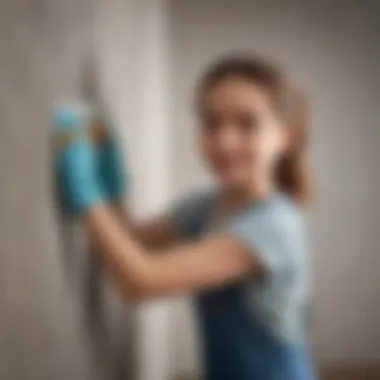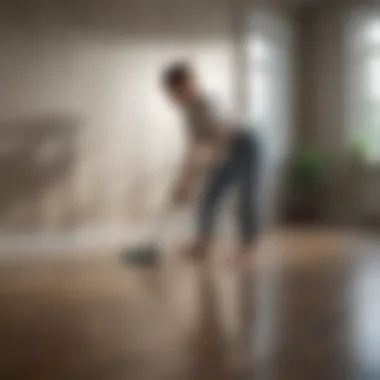Discover Effective Methods for Cleaning Walls in Your Home


Wellness
Cleaning the walls in your house is not just about maintaining a visually appealing living space; it also has a direct impact on your physical health. Walls tend to accumulate dust, dirt, and other allergens over time, which can trigger respiratory problems and allergies. By employing effective cleaning methods, you can create a healthier indoor environment for you and your family.
Tools for Living Better
When it comes to cleaning your walls, having the right tools is essential. Gather cleaning cloths, a bucket, mild detergent, a sponge, a soft-bristled brush, and a step ladder to reach higher areas. These tools will enable you to remove dirt and stains from your walls efficiently without causing any damage.
Choosing the Right Cleaning Agents
Selecting the correct cleaning agent is crucial for achieving pristine walls. Determine the type of paint or wall surface before choosing a cleaner. For painted walls, a mild soap and water solution usually suffice, while tougher stains may require a specialized wall cleaner. Always test a small, inconspicuous area first to ensure the cleaner does not cause any discoloration or damage.
Tips for Effective Wall Cleaning
To start, remove any dust or cobwebs using a dry microfiber cloth. Then, dampen a clean cloth or sponge in the cleaning solution and gently scrub the walls in a circular motion. Focus on one section at a time and rinse the cloth or sponge regularly. For stubborn stains, apply a bit more pressure but avoid scrubbing too vigorously to prevent paint damage.
Final Touches
After cleaning, rinse the walls with a separate cloth dampened with clean water to remove any soap residue. Dry the walls thoroughly with a fresh cloth to prevent streaks or watermarks. Additionally, consider applying a coat of paint or wall finish to maintain the walls' appearance and protect them from future stains. Regular cleaning and maintenance will ensure your walls remain in top condition for years to come.
Introduction
Walls are the silent guardians of our homes, yet they often endure the brunt of daily activities, accumulating dirt and grime over time. In this comprehensive guide, we delve into the myriad ways to effectively clean walls in your household. From the importance of maintaining clean walls to the frequency of cleaning, we will explore essential tips and techniques to ensure your walls remain pristine and aesthetically pleasing.
Importance of Clean Walls
Enhances overall aesthetics
Clean walls are not only visually appealing but also set the tone for the entire ambiance of your living space. The cleanliness of walls significantly impacts the overall look and feel of a room, making it a crucial aspect of home maintenance. A well-maintained wall contributes to a sense of cleanliness and orderliness, enhancing the aesthetic appeal of your home. However, neglecting wall cleaning can lead to a dingy and unkempt appearance, detracting from the beauty of your living environment.
Promotes better indoor air quality
Clean walls play a vital role in improving indoor air quality by reducing the accumulation of dust and allergens. When walls are free from dust and dirt, the air circulating in the room remains cleaner, creating a healthier living environment. Promoting better indoor air quality through regular wall cleaning can significantly benefit individuals, especially those prone to respiratory issues or allergies, by minimizing the presence of airborne pollutants.
Prevents the growth of mold and mildew
Regular wall cleaning helps prevent the growth of mold and mildew, two common household nuisances that thrive in damp and dirty environments. By eliminating moisture-trapping dirt and residual substances from walls, you can safeguard your home against the development of mold and mildew. These fungi not only pose health risks but also compromise the structural integrity of your walls, underscoring the importance of regular cleaning to maintain a mold-free environment.
Frequency of Wall Cleaning
Recommendations for regular cleaning
For optimal maintenance, it is advisable to clean your walls at regular intervals to uphold their cleanliness and condition. Establishing a cleaning routine based on the level of household traffic and environmental factors can help prevent dirt buildup and maintain the visual appeal of your walls. Regular cleaning not only enhances the longevity of wall finishes but also minimizes the effort required for deep cleaning sessions, ensuring that your walls remain in pristine condition.
Signs that indicate walls need cleaning
Certain indicators can signal that your walls require cleaning, such as visible dust accumulation, smudges, or discoloration. These signs not only detract from the appearance of your walls but also signify the presence of hidden dirt and contaminants. By being aware of these signals, you can address cleaning needs promptly and maintain the cleanliness of your walls effectively.
Seasonal cleaning tips
Seasonal variations can impact the cleanliness of your walls, necessitating adjustments in your cleaning routine. During high-humidity seasons, such as summer, walls may be more prone to mold growth, requiring targeted cleaning efforts. Incorporating seasonal tips, such as adjusting cleaning frequencies and using appropriate cleaning solutions, can help combat seasonal dirt and maintain clean walls throughout the year.


Tools and Materials
Basic Supplies
When it comes to cleaning walls effectively, having the right basic supplies is fundamental. Microfiber cloths stand out as a versatile and indispensable tool for wall cleaning. With their unique composition, microfiber cloths offer superior absorbency and a non-abrasive surface, making them ideal for wiping down walls without causing damage. Their lint-free nature ensures a streak-free finish, enhancing the overall cleanliness of the walls.
Warm water serves as another essential basic supply for wall cleaning. Its ability to dissolve dirt and grime effectively, without the need for harsh chemicals, makes it a environmentally-friendly and cost-efficient choice for cleaning walls. The use of warm water alongside other cleaning agents can enhance the cleaning power while being gentle on various wall finishes.
Mild detergent plays a crucial role in breaking down stubborn stains and grease on walls. Its gentle yet effective formula ensures thorough cleaning without causing harm to the wall surface. When diluted appropriately, mild detergent provides a safe and efficient solution for removing dirt and enhancing the aesthetics of walls.
Specialized Cleaning Equipment
In the realm of specialized cleaning equipment for walls, certain tools prove to be indispensable for a deeper and more thorough cleaning process. The sponge mop emerges as a valuable asset for cleaning larger wall surfaces efficiently. With its ability to hold ample cleaning solution and cover a wide area, the sponge mop expedites the cleaning process while maintaining effectiveness.
A soft-bristled brush becomes essential for targeted cleaning efforts, especially in hard-to-reach areas or textured wall surfaces. The gentle bristles of the brush ensure effective dirt removal without causing any harm to the walls. Its versatility and precision make it a valuable tool for detailed wall cleaning.
When it comes to removing dust and debris from walls, a vacuum cleaner with a brush attachment proves to be highly effective. This equipment not only collects loose dirt particles but also ensures a thorough cleaning of wall textures and crevices. The brush attachment enhances the cleaning process by agitating dirt for easier removal, improving overall cleaning efficiency.
Homemade Cleaning Solutions
Exploring homemade cleaning solutions for wall cleaning provides a natural and cost-effective alternative to commercial cleaners. The vinegar solution stands out as a powerful yet safe option for removing dirt and grime from walls. With its natural antibacterial properties, vinegar effectively cleans and disinfects walls, leaving behind a fresh scent.
Utilizing a baking soda paste offers a gentle abrasive action that aids in removing tough stains and grease buildup. Its mild yet effective nature makes it suitable for various wall surfaces, ensuring a deep and thorough cleaning process. Baking soda paste serves as a multipurpose cleaner that tackles both dirt and odor effectively.
A lemon juice mixture provides a natural and refreshing option for wall cleaning. The acidic nature of lemon juice helps break down stains and grease effectively, while its pleasant fragrance leaves walls smelling fresh. This homemade solution not only cleans walls but also helps to eliminate odors, making it a multipurpose and eco-friendly cleaning option.
Techniques for Cleaning Walls
Cleaning walls is a crucial aspect of maintaining a pristine home environment. The cleanliness of walls not only enhances the overall aesthetics of your living space but also contributes significantly to promoting better indoor air quality by preventing the build-up of dust and allergens. Additionally, regular cleaning helps in inhibiting the growth of mold and mildew, safeguarding both the structural integrity of your walls and the health of the occupants.
Preparation
Clearing the Area
Clearing the area before commencing with wall cleaning is a fundamental step that ensures optimal efficiency and effectiveness. By removing furniture, decorations, and any obstacles from the vicinity, you create unobstructed access to the walls, facilitating a more thorough cleaning process. This practice not only enables you to reach all areas of the walls but also minimizes the risk of accidental damage to surrounding objects. The convenience and methodical approach of clearing the area streamline the cleaning procedure, allowing for focused attention on wall surfaces without distractions.
Protecting Adjacent Surfaces
Protecting adjacent surfaces such as baseboards, trim, and flooring is essential to prevent inadvertent damage during the cleaning process. Utilizing protective measures like painter's tape, drop cloths, or plastic sheeting safeguards these surfaces from cleaning solutions and moisture, preserving their condition and finish. Implementing this precautionary step maintains the integrity of surrounding elements, preventing potential staining, discoloration, or water damage. The meticulous approach to protecting adjacent surfaces demonstrates a commitment to thoroughness and care in wall cleaning, ensuring a professional and immaculate outcome.
Test Cleaning Solution
Before applying any cleaning solution to the walls, it is imperative to perform a test in an inconspicuous area. Testing the cleaning solution on a small, hidden section of the wall allows you to assess its compatibility with the wall material and finish. This preliminary evaluation helps identify any adverse reactions, such as discoloration or damage, ensuring the selected cleaning solution is safe and effective for use. The practice of testing the cleaning solution instills confidence in its suitability, mitigating the risk of unintended consequences and guaranteeing a successful wall cleaning process.
Cleaning Process
Top to Bottom Approach
Adopting a top to bottom approach when cleaning walls is a strategic method that maximizes efficiency and minimizes recontamination. Starting from the highest point of the wall and gradually working downwards prevents dirty water or residue from dripping onto already cleaned areas, maintaining a consistently clean surface. This systematic technique optimizes workflow and ensures thorough coverage of the entire wall surface without the need for repetitive cleaning. The disciplined application of the top to bottom approach enhances the overall cleaning efficacy, resulting in impeccably clean walls with minimal effort.
Gentle Scrubbing Techniques
Incorporating gentle scrubbing techniques during the cleaning process is key to effectively removing dirt and stains while protecting the integrity of the wall surface. Utilizing soft-bristled brushes, microfiber cloths, or sponge mops enables you to dislodge grime and debris without causing damage or abrasion to the painted or wallpapered surfaces. The gentle scrubbing action loosens dirt particles for easy removal, ensuring a thorough yet non-destructive cleaning experience. This approach prioritizes the preservation of wall finishes while achieving optimal cleanliness, reflecting a meticulous and considerate cleaning methodology.


Rinsing and Drying
Concluding the cleaning process with thorough rinsing and drying procedures is essential to achieve a polished and flawless finish. Rinsing the walls with clean water removes any residual cleaning solution or dirt, leaving behind a fresh and residue-free surface. Proper drying, whether through air-drying or gentle towel patting, prevents streaking or water spots, maintaining the visual appeal of the walls. This meticulous attention to detail in rinsing and drying guarantees a pristine outcome, free of streaks or blemishes, showcasing the dedication to achieving immaculately clean walls.
Dealing with Stubborn Stains
Oil-Based Stains
Addressing oil-based stains requires specialized cleaning techniques to effectively lift and remove the oily residues from the wall surface. Employing absorbent materials like baking soda or cornstarch to absorb excess oil before gently blotting the stain with a cloth soaked in a mild detergent solution helps dislodge and emulsify the oil for thorough cleaning. The meticulous approach to treating oil-based stains ensures complete removal without compromising the integrity of the wall finish, achieving a blemish-free result.
Water Marks
Combatting water marks involves targeted cleaning methods to eliminate the visible discoloration and prevent further damage to the walls. Utilizing a vinegar solution or lemon juice mixture helps dissolve water stains, restoring the cleanliness and appearance of the affected areas. The proactive approach to treating water marks not only eradicates unsightly blemishes but also prevents the development of mold or mildew, maintaining a hygienic and appealing wall surface.
Crayon Marks
Removing crayon marks necessitates gentle yet effective techniques to erase the colorful residues without causing harm to the wall finish. Applying a paste of baking soda and water or using a soft-bristled brush with a mild cleaning solution helps break down the waxy pigments for easy removal. The meticulous approach to eradicating crayon marks ensures a thorough and flawless cleaning outcome, restoring the walls to their pristine condition without marring the surface or finish.
Specific Walls and Finishes
When it comes to painted walls, the type of paint used plays a significant role in determining the cleaning method. Latex paint, known for its durability and smooth finish, is a popular choice in many households. Its water-based formula allows for easy cleaning with mild detergents without damaging the paint surface. However, latex paint may not withstand harsh scrubbing, requiring gentle cleaning techniques to prevent chipping or discoloration.
On the other hand, oil-based paint offers a traditional, glossy finish that is both elegant and robust. While oil-based paint provides a more durable coating, it can be challenging to clean due to its sensitivity to certain cleaning agents. Care must be taken when removing stains from oil-based paint to prevent damaging the finish, making it imperative to test any cleaning solution on a small, inconspicuous area before widespread application.
Glossy finishes, often applied over latex or oil-based paint, enhance the aesthetic appeal of walls through their reflective properties. Cleaning glossy finishes requires special attention to avoid streaking or dulling the surface. Using microfiber cloths and gentle cleaning solutions specifically formulated for glossy surfaces is recommended to maintain their shine and vibrancy without causing abrasions.
Painted Walls
Latex paint
When it comes to latex paint, its water-based composition makes it a versatile and popular choice for interior walls. Latex paint dries quickly, emits fewer odors than oil-based alternatives, and provides a smooth, matte finish that is easy to clean. Due to its washability, latex paint is ideal for high-traffic areas, such as living rooms and kitchens, where frequent cleaning may be necessary. However, while latex paint resists mildew and moisture to some extent, it may not be as durable as oil-based paint, making it susceptible to scratches and scuffs over time.
Oil-based paint
Oil-based paint, characterized by its durability and glossy finish, offers a classic look that is favored for trim work and furniture. Unlike latex paint, oil-based paint takes longer to dry but forms a hard, protective layer that can withstand wear and tear. Additionally, oil-based paint provides better coverage for imperfections on surfaces, making it a preferred choice for intricate detailing on walls. However, cleaning oil-based paint requires gentle yet thorough methods to avoid stripping the finish and exposing the underlying surface.
Glossy finishes
Glossy finishes, whether applied over latex or oil-based paint, lend a luxurious sheen to walls that enhances their visual appeal. The reflective nature of glossy finishes adds depth and sophistication to any space, making them a popular choice for contemporary design schemes. However, cleaning glossy finishes requires extra care to avoid leaving streaks or residues that may detract from their luster. Using soft, lint-free cloths and non-abrasive cleaning solutions tailored for glossy surfaces is essential to preserve their radiant finish.
Wallpaper
Wallpaper, a versatile alternative to paint, presents a myriad of options in terms of texture, pattern, and material. When cleaning wallpaper, understanding the specific characteristics of the chosen type is essential to avoid damaging its surface. Vinyl wallpaper, known for its durability and moisture resistance, is a practical choice for areas prone to humidity, such as bathrooms and kitchens. The smooth surface of vinyl wallpaper allows for easy cleaning with mild detergents and damp cloths, making maintenance a simple task for homeowners looking to refresh their walls.
Textured wallpaper, available in a range of embossed designs, adds depth and dimension to walls while camouflaging imperfections. Cleaning textured wallpaper necessitates a delicate approach to prevent flattening or distortion of its textured surface. Gentle vacuuming with a soft brush attachment is recommended to remove dust and debris without altering the wallpaper's intricate patterns.
Preventing damage during cleaning is paramount when dealing with wallpaper to ensure its longevity and visual appeal. Regular inspections to identify stains or discoloration can prompt timely cleaning interventions, preventing the need for harsh cleaning methods that may harm the wallpaper. Implementing preventive measures such as sealing seams and edges can also safeguard wallpaper from moisture infiltration during cleaning, preserving its aesthetic value for years to come.
Professional Cleaning Services
Professional cleaning services play a crucial role in ensuring the cleanliness and upkeep of walls in your home. These services offer a level of expertise and efficiency that may be challenging to achieve with DIY methods alone. By employing professional cleaners, you can benefit from their specialized tools, knowledge, and techniques, resulting in a thorough and effective cleaning process that enhances the overall appearance and longevity of your walls.
When to Consider Professional Help


Extensive dirt and grime buildup
Extensive dirt and grime buildup on walls can be a daunting task to tackle independently. The accumulation of dirt over time can lead to stubborn stains and discoloration that are difficult to remove with regular cleaning methods. Professional cleaners have the expertise and equipment to effectively eliminate tough grime, restoring your walls to their pristine condition without causing damage.
Specialized wall materials
Certain wall materials, such as delicate wallpapers or specialized coatings, require gentle handling and specific cleaning solutions to prevent damage. Professional cleaners are trained to identify these materials and use appropriate techniques to clean them without compromising their integrity. By engaging a reliable service, you can ensure that your unique wall finishes are maintained and preserved for long-term enjoyment.
Time constraints
In today's fast-paced lifestyle, finding time for extensive wall cleaning can be challenging. Professional cleaning services offer a convenient solution for individuals with busy schedules or those who prefer to delegate cleaning tasks. By entrusting the cleaning to professionals, you save time and effort while achieving exceptional results. Consider hiring a professional service when time limitations make it difficult to prioritize thorough wall maintenance.
Choosing a Reliable Service
Credentials and reviews
When selecting a professional cleaning service, it is essential to consider their credentials and reviews. Look for companies with a solid reputation and positive feedback from previous clients. Verified credentials and testimonials indicate a level of trustworthiness and quality service, ensuring that your walls are in good hands.
Service guarantees
Reliable cleaning services often provide service guarantees to assure clients of satisfactory results. These guarantees offer peace of mind, allowing you to request further assistance if the initial cleaning does not meet your expectations. By choosing a service with clear guarantees, you can trust in their commitment to delivering exceptional service and ensuring customer satisfaction.
Cost considerations
While cost is a significant factor in selecting a cleaning service, it is essential to weigh the expenses against the value provided. Consider the services included in the pricing, such as specialized cleaning techniques, equipment, and materials. Opt for a service that offers transparent pricing structures and assess the cost relative to the quality of service offered. Balancing affordability with quality can help you choose a reliable cleaning service that meets your specific requirements.
Maintenance Tips
When it comes to maintaining clean and pristine walls in your house, focusing on maintenance tips is crucial. Regular inspections play a significant role in ensuring the longevity and appearance of your walls. Regular inspections help in identifying early signs of dirt, which, if addressed promptly, can prevent the accumulation of tough stains and grime.
Regular Inspections
Spotting Early Signs of Dirt
Spotting early signs of dirt is an essential aspect of wall maintenance. By observing closely for any discoloration, dust buildup, or markings, you can address these issues before they worsen. This proactive approach not only keeps your walls looking fresh but also minimizes the need for intensive cleaning sessions in the future. Spotting early signs of dirt allows you to take immediate action, maintaining the aesthetic appeal of your living space.
Addressing Issues Promptly
Addressing issues promptly is key to preserving the cleanliness of your walls. Once you spot any signs of dirt or damage during your inspections, addressing them without delay prevents the issues from escalating. Whether it's a small stain or a scuff mark, quick action can significantly impact the overall condition of your walls. By promptly addressing issues, you save time and effort in the long run, ensuring that your walls remain in top condition.
Preventive Measures
Implementing preventive measures is a proactive approach to wall maintenance. Regular dusting, avoiding moisture build-up, and using protective coatings are effective preventive measures. These steps help in reducing the likelihood of dirt accumulation and damage to your walls over time. By taking preventive actions, you establish a routine that safeguards the cleanliness and longevity of your walls, contributing to a healthier indoor environment.
Long-Term Care
Long-term care strategies are essential for maintaining the quality of your walls over an extended period. Applying protective coatings serves as a barrier against dirt and stains, prolonging the life of your walls. Scheduling deep cleaning sessions at regular intervals ensures thorough removal of dirt and grime, preserving the integrity of the wall surfaces. Updating wall finishes not only enhances the visual appeal but also provides added protection against wear and tear.
Application of Protective Coatings
The application of protective coatings forms a shield over your walls, preventing dirt and stains from penetrating the surface. This protective layer simplifies cleaning and maintenance while ensuring that your walls retain their original sheen. The use of protective coatings is a cost-effective method to safeguard your walls against daily wear and tear, maintaining a fresh and clean appearance.
Scheduling Deep Cleaning
Scheduling periodic deep cleaning sessions is vital for removing embedded dirt and ensuring a thorough refresh of your walls. Deep cleaning reaches areas that regular maintenance may overlook, restoring the walls to their pristine condition. By setting a schedule for deep cleaning, you establish a routine that upholds the cleanliness and hygiene standards of your living spaces.
Updating Wall Finishes
Updating wall finishes revitalizes the look of your walls while providing enhanced protection. Whether by repainting, applying textured finishes, or incorporating new design elements, updating wall finishes adds a fresh dimension to your living environment. Choosing modern finishes not only elevates the aesthetics but also reinforces the resilience of your walls against daily wear and tear.



